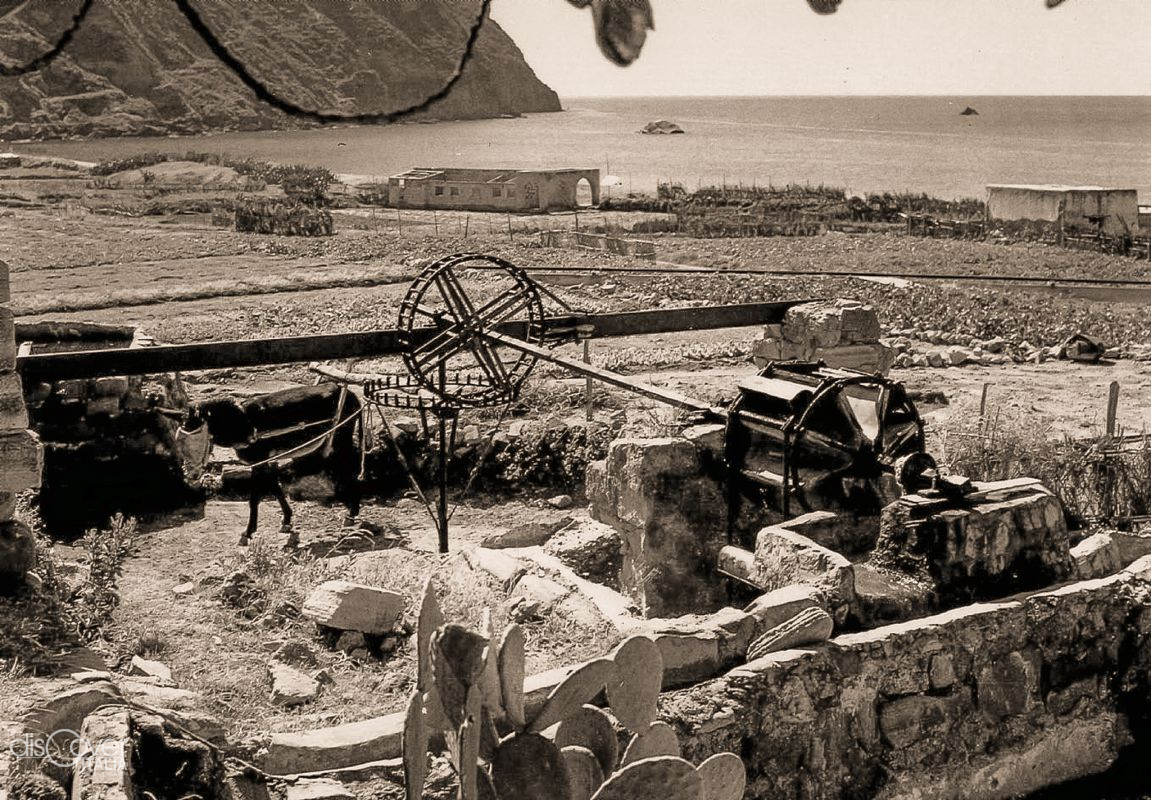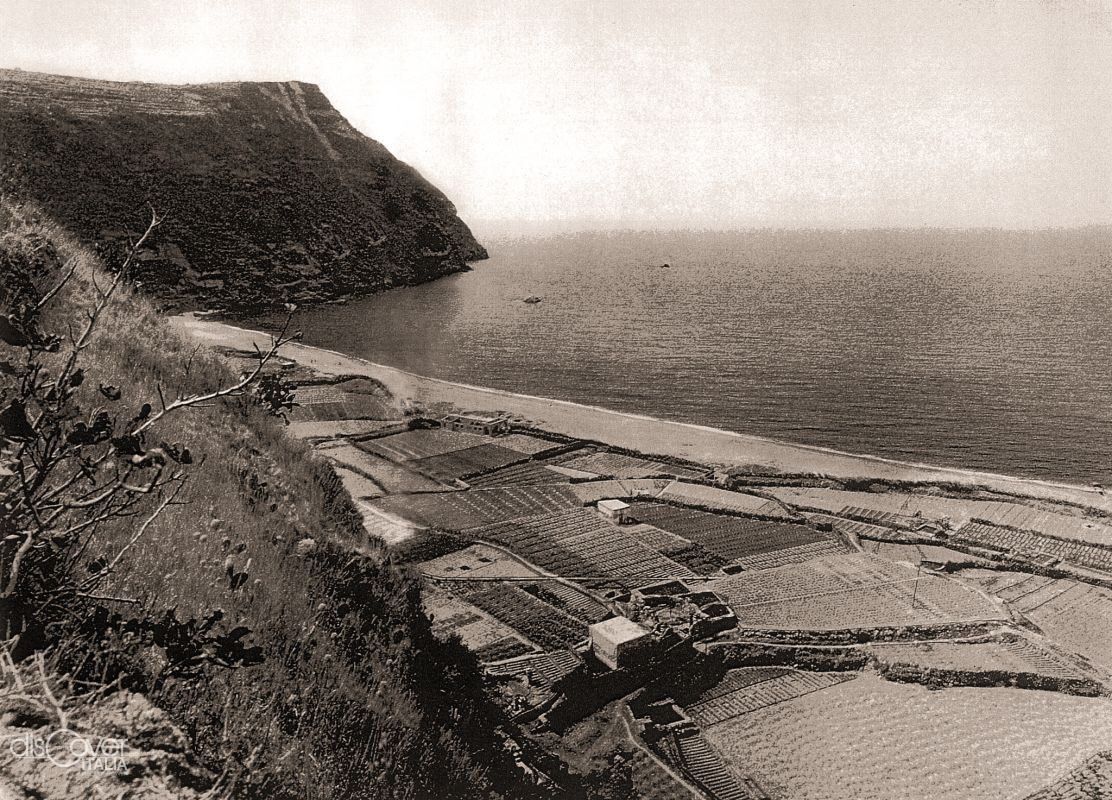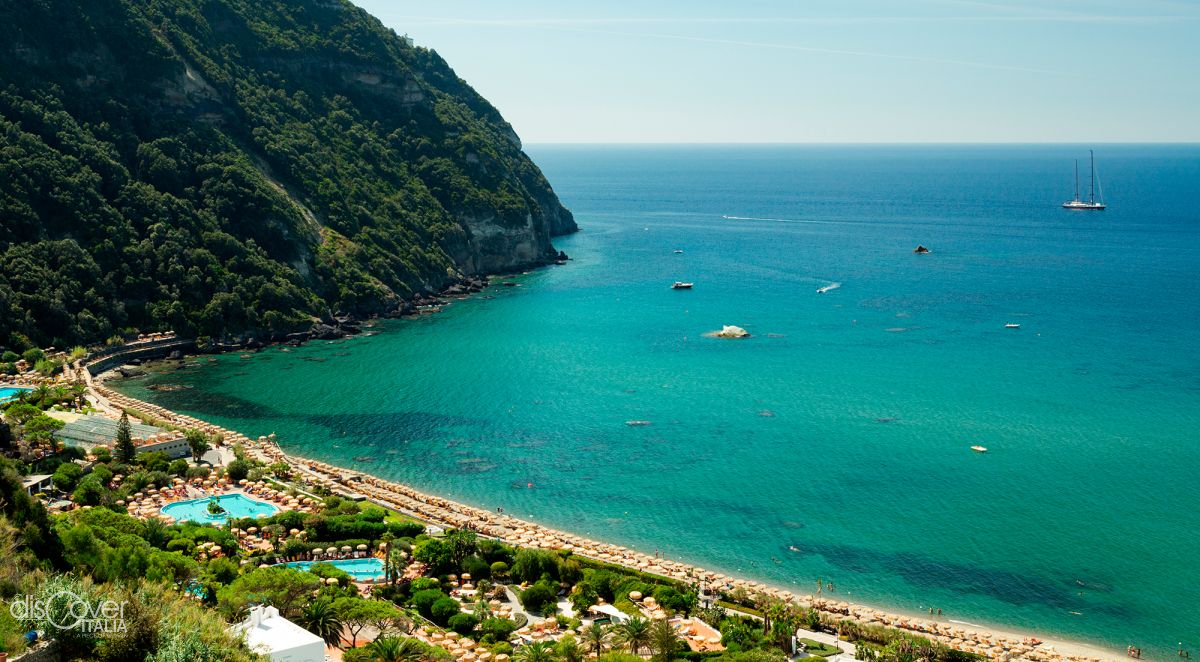With its slow, circular, uninterrupted movement, the donkey covered kilometers after kilometers without leaving its position, under the sun, faithful companion from dawn to dusk.
 Blindfolded the entire time, the quadruped carried out his ungrateful but indispensable task to turn the big wheel that quenched the thirst of the green valley. One after the other, the large buckets of the noria fished into the earth, drawing the precious water to be collected in the large pool where it would remain all night to cool-down, before being distributed in the welcoming holes. Emerging from the ground and raising a thick curtain of steam, that liquid was impossible to use in the garden. Too hot and rich in salt, it would have destroyed the seedlings on first contact. Yet, those characteristics, once "weakened", were the secret of the renowned first fruits of Citara. The women were in charge of selling those very requested products in every district of the island and also in Naples. Regularly, every week, the ships headed for the city went to load the vegetables produced in the thriving soils behind the sandy strip, which stretched for more than a kilometer between the Capizzo promontory and the more imposing one of Punta Imperatore, with its ancient lighthouse.
Blindfolded the entire time, the quadruped carried out his ungrateful but indispensable task to turn the big wheel that quenched the thirst of the green valley. One after the other, the large buckets of the noria fished into the earth, drawing the precious water to be collected in the large pool where it would remain all night to cool-down, before being distributed in the welcoming holes. Emerging from the ground and raising a thick curtain of steam, that liquid was impossible to use in the garden. Too hot and rich in salt, it would have destroyed the seedlings on first contact. Yet, those characteristics, once "weakened", were the secret of the renowned first fruits of Citara. The women were in charge of selling those very requested products in every district of the island and also in Naples. Regularly, every week, the ships headed for the city went to load the vegetables produced in the thriving soils behind the sandy strip, which stretched for more than a kilometer between the Capizzo promontory and the more imposing one of Punta Imperatore, with its ancient lighthouse.
Aphrodite’s Foam
It was renown for its fertility, that site along the west coast of the island. Long before its large and juicy tomatoes became famous, the first to redden in Ischia. The Greeks of Pithekoussai had wanted to dedicate it to the cult of Aphrodite, with a temple built in a spot reached by this fertilizing foam coming from the sea. The legend, transformed into literature and delivered to posterity in the 14th century by the historian GiovanniVillani in his Nova Cronica, identified in that sacred building, where the beautiful Helen would go in prayer to the goddess, the theater of her kidnapping and the beginning of the Homeric war between Greeks and Trojans. Besides the myth, the existence of the temple was witnessed by the large white marble statue depicting Venus Citerea found on the shore of Ischia, where it would have defied the centuries until 1792, when it was inexplicably destroyed. But the bond with Aphrodite was meant to remain in that place forever. In the name, Citara, and in her vocation as a land of fertility.

That rich underground spring
The hot water useful for crops was identified by the Pithecusans as a healthy liquid, source of fertility. And of course that extraordinary thermal resource, emerged as soon as one dug a few centimeters into the valley lapped by the sea, didn’t go unnoticed by the Romans. Back then was much wider, including the beach, considering that the large rocks known as White, Black and Red Stone, that once were within the coastline, now emerge from the sea at a distance of several tens of meters. And before it was re-conquered by the sea, it was right next the RedStone, colored by the vapors of the fumaroles, which holes were usually dug to take advantage of the healthy water. Thus, in the 14th century, at the time of Villani, Citara was mentioned in a document among the five most active and frequented swimming spot on the island of Ischia.
 It was two centuries later, when Ischia's thermalism began to be scientifically studied, that GiulioJasolino identified the specific characteristics of Citara’s water, giving advices on its most appropriate therapeutic use. Which mainly concerned the fight against both male and female sterility: "it is worth the spasm ... to sterile women, it makes men and women shed the semen, the inhabitants of the place have experienced how it restores weakened forces and also makes amorous battles much more powerful and robust… it helps sterile women to conceive, to those who lactate, it marvelously increases milk», the Calabrian scholar said. A description / prescription destined to teach and to be rigorously followed in the future by the island doctors, that between the 18th and 19th centuries welcomed and directed those who arrived from all over Europe to the numerous thermal springs of Ischia, to find remedy to their various health problems.
It was two centuries later, when Ischia's thermalism began to be scientifically studied, that GiulioJasolino identified the specific characteristics of Citara’s water, giving advices on its most appropriate therapeutic use. Which mainly concerned the fight against both male and female sterility: "it is worth the spasm ... to sterile women, it makes men and women shed the semen, the inhabitants of the place have experienced how it restores weakened forces and also makes amorous battles much more powerful and robust… it helps sterile women to conceive, to those who lactate, it marvelously increases milk», the Calabrian scholar said. A description / prescription destined to teach and to be rigorously followed in the future by the island doctors, that between the 18th and 19th centuries welcomed and directed those who arrived from all over Europe to the numerous thermal springs of Ischia, to find remedy to their various health problems.
In Citara, the advance of the sea, linked to the slow lowering of the island, later swallowed the site of the Red Stone, where also was a salt mine important for the local economy. But the rich vein of underground thermal water was intercepted elsewhere, towards Punta Imperatore, continuing to be a destination for foreigners and locals that also found a poor building used for baths.
To benefit from it, according to a narration handed down over time, was also a queen. At the very beginning of the 20th century, in the middle of the summer, a military ship returned to the bay for several days. Each time, a group of women went ashore, spending time at the baths of Citara, before returning to board. From mouth to mouth it was whispered that among the visitors there also was Queen Elena, who had not yet given an heir to Vittorio Emanuele III. Their first daughter, Iolanda, arrived the following year ...
From abandonment to rebirth in the sign of water
Although largely used for prosperous horticultural crops, the valley of Citara was also a point of reference for thermal baths, increasingly famous abroad as well. But the recognized quality of the underground hot water and the advantages of a microclimate that renowned scientists had praised as ideal for its health, was on contrast with the poor state of the spa site, almost abandoned. On the other hand, starting from the 1930s, interest had grown in the possible use of the thermal vapors of Citara for the production of electricity and drilling had begun to exploit the endogenous forces of the area. Thus, not far from the norias activated by the movement of donkeys, a small thermoelectric power plant was built, little more than an experiment, carried out at the end of the Second World War, until 1956, when the idea was abandoned.

The time of abandonment of the agriculture also arrived, in the 60’. And the fertile valley on the sea also lost that vital dimension of its identity, without another being highlighted yet. While the spa heritage was neglected and misunderstood, arousing amazement among those who visited that corner of paradise. Then, unexpectedly, the turning point with a German name came, GernotWalde, a doctor who had fallen in love with the uniqueness of Citara, modeling on its multiple environmental characteristics the project of a place of well-being for the mind and body between the sea, spas and nature. Thus was born the first thermal park, destined to become a peculiar element of thermalism on the island of Ischia. Walde's intuition found full fulfillment in the seventies, thanks to a Bavarian doctor, LudwigKuttner, who took care of the valley and the beach, creating the PoseidonGardens. Where the hot and precious water of Citara has found its full value, feeding the swimming pools and the healthy paths of the thermal park and in the luxuriance of the well kept surrounding vegetation.
From Aphrodite to Poseidon, today it’s a large bronze statue of the god of the sea, according to the features imagined by Phidias, who watches over the fertility valley of the island of Ischia.
{SCOpenGraph image=https://discovercampania.it/images/Giardini-poseidon-post.jpeg}






Comments powered by CComment